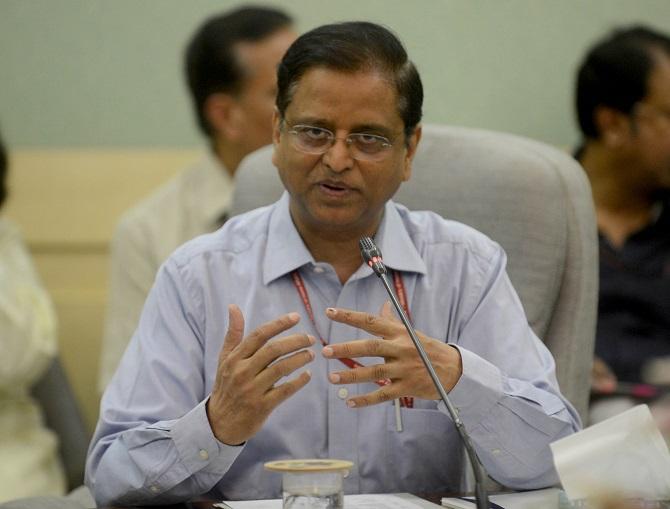 | « Back to article | Print this article |
Why did the government think it was necessary to shift Subhash Garg from the finance ministry to the power ministry? More importantly, why did Garg let it be known a day after his transfer that he had sought voluntary retirement from government service, asks A K Bhattacharya.

Transferring a finance secretary to another ministry, which is relatively less important, is unusual.
For any government official, in particular an Indian Administrative Service (IAS) officer, becoming a finance secretary is considered to be a hard-earned achievement.
The finance ministry has five secretaries. Only one of them becomes the finance secretary, who is the first among equals.
Most finance secretaries don’t end their careers with superannuation; their services are used in various capacities as heads of committees or regulatory bodies and sometimes as members of other government institutions.
Not surprisingly, therefore, the Narendra Modi government’s decision on July 24 to transfer Subhash Garg, who was then the finance secretary, to the power ministry as its secretary became a talking point in government and political circles.
The obvious question was, what went wrong for Garg all of a sudden after having served the finance ministry for about two years?
Garg was known for his comments, which his critics would often describe as bold but also irresponsible. His relation with the Reserve Bank of India was stressful.
Regulators like the RBI and even the Securities and Exchange Board of India (Sebi) were reportedly apprehensive of how Garg would moot ideas that would dilute their jurisdictional power. The markets, too, were concerned about Garg’s announcements on the government’s borrowing plans in the middle of the year.
But as in the case of most senior bureaucrats, there was never any doubt that Garg was not sticking to his brief. He appeared to be all the time carrying out instructions that the government had issued to him.
So, if Garg appeared to be keen on securing a large share of the RBI’s surplus reserves or upset the RBI governor through his statements or tweets, nobody concluded that his actions did not have the tacit backing of the government.
In the government system, bureaucrats don’t do things on their own. They do what the political leadership wants them to do. Garg was no exception. Even when Garg outlined the action plan to implement the Budget idea of the government floating sovereign bonds to borrow from external markets, the finance secretary was following the government brief.
So, why did the government think it was necessary to shift Garg from the finance ministry to the power ministry? More importantly, why did Garg let it be known a day after his transfer that he had sought voluntary retirement from government service? These developments make it clear that the government had a purpose in mind when it decided to transfer Garg to the power ministry.
And equally important, these developments show that Garg had no hesitation in making public his decision to leave the government. Was Garg lodging his protests against the government’s transfer move?
Two dates are important to note in this context. On July 17, a committee, headed by former RBI governor Bimal Jalan, met to discuss the manner in which the central bank’s surplus reserves could be shared with the government. One of the members of this committee was Garg, who, according to reports, declined to sign on the report and its recommendations.
The very next day, July 18, Garg had a meeting at the Prime Minister’s Office where, according to him, he discussed his voluntary retirement plans. Garg himself revealed that he discussed his plan to retire early -- more than a year before he would turn 60 -- at the PMO on July 18.
The answer to the question on why Garg was shifted to the power ministry and why he later made public his decision on seeking early retirement has to be found in the meetings that took place on July 17 and 18.
It appears that Garg’s approach to the Jalan Committee’s deliberations did not win him any friends either among its members or in the government. Indeed, his tough line was not appreciated by even the government.
Most likely, Garg’s transfer was a consequence of what happened on these two days.
There was yet another factor that complicated the situation for Garg. The Indian economy was slowing, facing many headwinds. Many of the provisions in the Budget had upset the markets and industry.
In such a situation, the government deciding to send its finance secretary to the power ministry was also construed as a signal to those who were worried about the economic situation and the Budget provisions.
So, the departure of Garg was seen as a punishment for the officer in charge of the economy’s management. And Garg’s announcement of having sought voluntary retirement was seen as his protest against his transfer.
In the last two decades, only three finance secretaries have been transferred to less important ministries. In 2000, Piyush Mankad was sent off to the ministry of industry. In 2014, Arvind Mayaram was sent to the tourism ministry, initially, and later to the minority affairs ministry. And now Garg has been sent to the power ministry.
All the transfers were ordered when the government was led by the Bharatiya Janata Party.
Neither Mankad nor Mayaram chose to seek voluntary retirement from service and completed their remaining months in service.
But Garg has followed a different path and hence speculation over why the government shifted him and why he has sought voluntary retirement will remain intense.